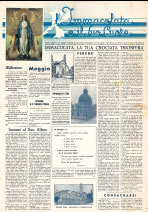"THE IMMACULATE AND HIS HEART" – JUNE 1949
HISTORY THE ROSARY
Super-DA “FRIHS ecclesiastic RECORD” DUBLIN.
The 'Marco Polo' entered the port in Alexandria to an ¬ dici morning. It was a day ¬ nataccia, hot hot, in July 1937 and had little desire to turn.
I remembered that decrepit proverb says that “time is gold 'and I decided, helmet on her head, to fall in the famous city and not lose even a minute.
There at the dock was a handsome high distinct. Dressed a pair of white trousers, a blue jacket and a dark red fez on his head. In a hand-held crown and large white beans: Ivory!
I asked a guide, ready to my landing:
- Tell me, because what it takes that necklace in your hand?
- It is not a series, Father, is a crown.
- And what is the use?
- In general it is a pass time, a trinket, but for a good Muslim is a means of prayer. 99 grains are used to count the 99 attributes of Allah (God). Moving between the fingers of the crown grains they say, for example, Allah is great, Allah is powerful, Allah is good, Allah is Holy .... etc..
- It's a kind of Rosario (I thought, between me and me).
Meanwhile, the man rose and fell from the trunk by turning the crown in his hands.
Moreover, a lay brother of St. Francis Xavier said he had seen in 1549 at the Japanese crown of 108 grains and every grain they recited a prayer that had long twice our “Pater Noster”.
Marco Polo points out that the ruler of Malabar led a series of 104-grain (of pearls and rubies) to sing the prayers in the morning and evening.
The Christians were, too, the same system, 'The ancient hermits and the Fathers of the desert used ropes with knots at regular intervals, and other stones or to distribute their prayers.
Santa Brigida was using a kind of Rosario and Santa Geltrude so.
In the tombs of St 1160 have been found of rosaries. 1134 and Santa Rosalia (Norbert)
In Europe and for a long time, rosaries were called Pater Noster used to count because as you say.
Operation is still in force in the Secular Franciscan crown where a special need to lay brothers and replace, in certain difficult cases, the psalms of sacer ¬ talents.
In England they sold many rosaries and abundant street where the sale was called Paternoster Road.
In Rome, Paris and other places there was a real craft.
For a time the Rosary was called 'Psalter of Our Lady' and indeed, blessed by Alano Rupe, an apostle of the Rosary, said that the name pink ¬ rio was too mundane because it was derived from a series of ladies etc..
At first there was the use of reciting Psalms 150 (salte ¬ rio).
At the first Irish monasteries that prayer was ¬ mol to widespread and because it was divided into three parts; salmi 50 each, called it “the three 50” and in the thirteenth century in England monaste re ¬ applied two priests' Mass' for the dead, and lay brothers' two 50 “.
Soon the 150 psalms were replaced by 150 “Pater Noster” which means all of it up sometimes, sometimes ¬ 100, or only 50.
START OF ROSARIO
During the Middle Ages took the field devotion of the Hail Mary, which replaced the 150 Pater and often, every Ave was accompanied by prayer.
The Ave Maria, particularly as devotion, was the Middle Ages in the liturgy to the east 500 AD is the form 'Hail Mary full of grace, the Lord is Teco, then in 1100 it added the words of St. Elizabeth: “Blessed among women and blessed is the fruit of your womb” so then in the Rosary prayer was much shorter than that of today.
In 1300 it was added the words “Jesus, amen” or “Jesus Christ, amen, glorious and blessed God for eternity.”
Between 1300 and i500 is introduced the words Holy Mary Mother of God, pray for us sinners. “
St. Pius V, in 1568 took the stand.
Father Bonaventura Raschi
